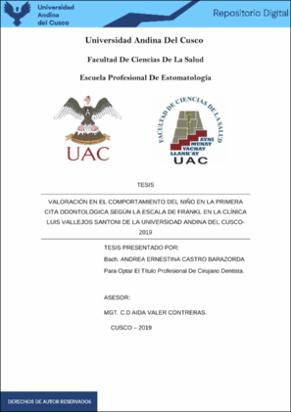| dc.contributor.advisor | Valer Contreras, Aida | |
| dc.contributor.author | Castro Barazorda, Andrea Ernestina | |
| dc.date.accessioned | 2021-05-20T02:34:38Z | |
| dc.date.available | 2021-05-20T02:34:38Z | |
| dc.date.issued | 2019-12-19 | |
| dc.identifier.uri | https://hdl.handle.net/20.500.12557/3811 | |
| dc.description.abstract | El comportamiento es la forma de proceder que tienen las personas
u organismos ante los diferentes estímulos que reciben y en relación al entorno
en el cual se desenvuelven, por ello cada niño actuará de diferentes manera en
la primera cita odontológica, para lo cual el odontólogo debe tener la capacidad
de guiar al niño a través de su experiencia, es por ello que se utilizó un
instrumento adecuado para darle un valor de acuerdo a las variables
establecidas, con el Objetivo de determinar la valoración en el comportamiento
del niño en la primera cita Odontológica según la escala de Frankl en la Clínica
Luis Vallejos Santoni de la Universidad Andina del Cusco-2019. Se trabajó con
una muestra de 40 niños que asistieron por primera vez a su cita odontológica
en el área de odontopediatría clínica; teniendo este estudio una metodología de
tipo transversal, con un diseño descriptivo-observacional de enfoque cualitativo;
obtuvimos una muestra constituida por 40 pacientes niños de 3 a 6 años de edad
que acudieron a la Clínica Luis Vallejos Santoni, de las cuales 18 pacientes
fueron femeninas y 22 pacientes masculinos, de las cuales se abarco dos
aspectos importantes: la escala de Frankl, que son de: tipo I definitivamente
negativo, tipo II negativo, tipo III positivo, tipo IV definitivamente positivo y el tipo
de acompañante. Una vez aplicada la ficha de recolección de datos se agruparon
los resultados en cuatro grupos tipo I definitivamente negativo, tipo II negativo,
tipo III positivo, tipo IV definitivamente positivo, se concluyó que el
comportamiento del niño en la primera cita odontológica tiende a variar según
sexo, edad y acompañante; pudiendo observar que el sexo femenino mostró una
mejor conducta; los niños de menor edad tuvieron un comportamiento negativo y en cuanto al acompañante se comprobó que en su mayoría los pacientes niños
tuvieron un comportamiento positivo, cuando el acompañante era directo. | es_PE |
| dc.description.abstract | Behavior is the way of proceeding that people or organizations have before the
different stimuli they receive and in relation to the environment in which they
operate, so each child will act differently at the first dental appointment, for which
the dentist must Having the ability to guide the child through their experience is
why an appropriate instrument was used to give it a value according to the
established variables. The purpose of this research is to determine the
assessment of the child's behavior at the first Dental appointment according to
the Frankl scale at the Luis Vallejos Santoni Clinic of the Andean University of
Cusco-2019. We worked with a sample 40 children who first attended their dental
appointment in the area of pediatric dentistry. This being a cross-descriptive
study, with a descriptive-observational design, qualitative approach; We obtained
a sample consisting of 40 children patients from 3 to 6 years of age who attended
the Luis Vallejos Santoni Clinic, of which 18 child patients were female and 22
male child patients which covered two important aspects: The Frankl type scale I
definitely negative, type II negative, type III positive, type IV definitely positive and
the type of companion. Once the data collection sheet was applied, the results
were grouped into four groups of type I definitely negative, type II negative, type
III positive, type IV definitely positive. The child's behavior at the first dental
appointment tends to vary according to sex, age and companion; being able to
observe that the feminine sex showed a better behavior, the children of younger
age usually have a negative behavior and as for the companion it was verified
that in their majority they had a positive behavior when the companion is direct. | en_US |
| dc.description.uri | Tesis | es_PE |
| dc.format | application/pdf | es_PE |
| dc.language.iso | spa | es_PE |
| dc.publisher | Universidad Andina del Cusco | es_PE |
| dc.rights | info:eu-repo/semantics/openAccess | es_PE |
| dc.rights.uri | https://creativecommons.org/licenses/by-nc-nd/2.5/pe/ | es_PE |
| dc.source | Universidad Andina del Cusco | es_PE |
| dc.source | Repositorio Institucional UAC | es_PE |
| dc.subject | Cita odontológica | es_PE |
| dc.subject | Niños menores | es_PE |
| dc.subject | Conducta | es_PE |
| dc.subject | Comportamiento | es_PE |
| dc.title | Valoración en el comportamiento del niño en la primera cita odontológica según la Escala de Frankl en la Clínica Luis Vallejos Santoni de la Universidad Andina del Cusco2019 | es_PE |
| dc.type | info:eu-repo/semantics/bachelorThesis | es_PE |
| thesis.degree.name | Cirujana Dentista | es_PE |
| thesis.degree.grantor | Universidad Andina del Cusco. Facultad de Ciencias de la Salud | es_PE |
| thesis.degree.level | Titulo Profesional | es_PE |
| thesis.degree.discipline | Estomatología | es_PE |
| dc.publisher.country | PE | |
| dc.subject.ocde | https://purl.org/pe-repo/ocde/ford#3.02.14 | en_US |
| renati.advisor.dni | 06437563 | |
| renati.advisor.orcid | https://orcid.org/0000-0002-7589-0840 | en_US |
| renati.author.dni | 72781852 | |
| renati.discipline | 911016 | |
| renati.juror | Urbiola Camacho, Rudyard Jesus | |
| renati.juror | Ucañani Ascue, Nancy Elizabeth | |
| renati.juror | Tipian Tasayco, Martin Wilfredo | |
| renati.juror | Gomero Huarcaya, Valery Kimiyo | |
| renati.level | https://purl.org/pe-repo/renati/level#tituloProfesional | es_PE |
| renati.type | https://purl.org/pe-repo/renati/type#tesis | es_PE |


